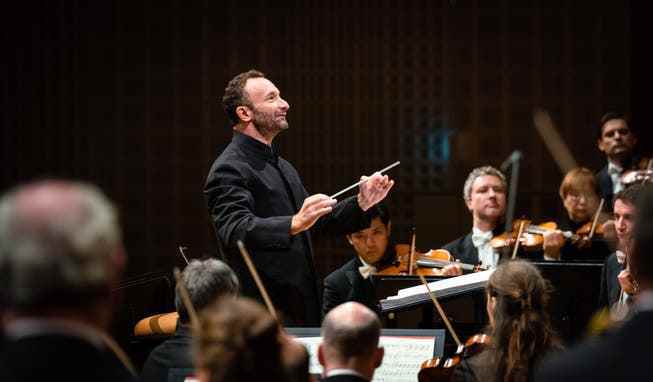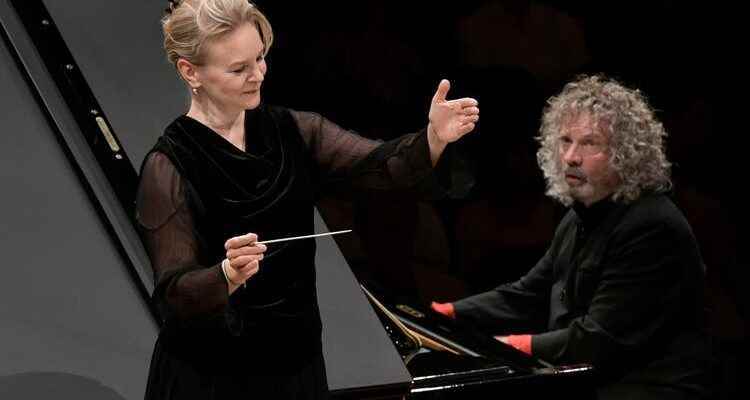Kirill Petrenko and the Berlin Philharmonic dissect Mahler’s 7th Symphony, Dieter Ammann demands the utmost from both players and listeners with his piano concerto “Gran Toccata” – two fascinating tightrope walks in Lucerne.
It’s all a question of coordination: the conductor Susanna Mälkki and the soloist Andreas Haefliger at the Swiss premiere of Dieter Ammann’s piano concerto at the KKL.
At some point the ear goes on strike. With more than eighteen tones per second it’s over. Then people no longer hear clearly separated individual tones, but a continuous, vibrating stream of sound. The fascinating phenomenon, strictly speaking a deliberate overload of our sense of hearing, has the composer György Ligeti as its famous The harpsichord piece «Continuum» is stimulated – up to sixteen beats per second are achieved here. The more, the better, because it is precisely at this threshold of perception that the music begins to shimmer and float in a peculiar way.
A similar impression was made at the Swiss premiere of Dieter Ammann’s “Gran Toccata” at the Lucerne Festival. The Aargau composer, who runs the local festival academy together with Wolfgang Rihm, has condensed the solo part of his piano concerto, which premiered in London in 2019, in such a way that the individual musical event also takes a backseat to the perception of vibrant areas of color that pulsate with gripping rhythms. At the same time, while listening, one asks oneself, quite aghast, how one person can fit so many notes in such a small space.
border crossing
Andreas Haefliger can do it. The younger brother of the festival director is the initiator and dedicatee of the work, which was written from 2016, and also worked on the solo part in intensive exchange with Ammann. Nevertheless, the live performance is a physical and mental peak performance, not least because the idea of crossing borders, even of excess, is inscribed in the piece.
Ammann takes the form of the toccata, which was primarily developed in baroque organ music, to the extreme. Many characteristics of the “stylus phantasticus” cultivated by Bach return here in an increased form: above all, the highly virtuoso, seemingly free improvisational gesture and the desire for ostinato structures, i.e. constantly repeating figures and rhythms that develop a pull, a real groove . That’s no coincidence, after all, Ammann was socialized as a practicing musician in jazz and has never had any reservations about contact with rock music, for example.
At the same time, the piano part is peppered with all the finger-breaker refinements that were devised for the instrument by Chopin and Liszt through to Ligeti. The result is colourful, stylistically diverse, but anything but a fashionable crossover. One thinks more of the abundance of shapes in hidden object pictures, which reveal new details every time you look at them. This is also the case here, when Haefliger repeats a longer excerpt from the solo part as an encore, which only reveals its full wealth of detail without being embedded in the equally densely woven orchestral movement.
“Father of Modernism”
The celebrated premiere of “Gran Toccata” at the KKL was part of the annual “Räsonanz” concert made possible by the Ernst von Siemens Music Foundation, this time performed by the Helsinki Philharmonic Orchestra under the direction of Susanna Mälkki. As the unusual spelling suggests, each of the programs intelligently “reasons” about musical phenomena, in this case about the changes in sound. With the beginning of modernity, this is no longer just responsible for the mere dressing of the melody, it rather acquires an intrinsic value. Today the Finn Kaija Saariaho continues this development with the neo-impressionism of her most recent orchestral work “Vista” from 2019; its sparkling play of colors opened the Lucerne concert.

Kirill Petrenko has been chief conductor and artistic director of the Berlin Philharmonic since 2019.
Colorfulness as a mirror of the increasingly polyphonic, even more dissonant-sounding world is not, however, an achievement of modernity. In his symphonies, Gustav Mahler already translated the diversity of life into a colorful juxtaposition of sounds and styles, from natural sounds and military fanfares to sky-storming chorales. The centrifugal forces in this musical world theater are only tamed by the late-Romantic, expansive instrumentation – at least that’s what people thought. Meanwhile, Kirill Petrenko and the Berlin Philharmonic show in their Lucerne guest performance the next day that Mahler deserves the honorary title “Father of Modernism” with regard to the orchestration.
Petrenko dissects the 7th symphony from 1905 in such a way that the individual instrumental colors appear almost unmixed and in harsh contrasts. The surprising changes in lighting, cuts and cross-fades reveal techniques that are now associated with film. Sometimes Petrenko almost seems to zoom into the score when he focuses on individual groups of instruments with rarely heard details. As with Simon Rattle, Mahler is closer to Expressionism than to Romanticism, and one understands why the Seventh in particular became a starting point for Arnold Schönberg.
The price for this strictly rational concept is a certain lack of direct emotionality. The technically flawless but cool brilliance that has increasingly shaped the sound of the Berlin Philharmonic since the end of the Claudio Abbado era – it even seems to disturb Petrenko himself. Despite a foot injury that actually forces him to take it easy, he seems to encourage the orchestra to express itself even more with expansive gestures, dances and jumps, but without loosening the tight reins. This leads to an overvoltage that seems a bit breathless. The wild finale, however, is well suited to the virtuoso escalation: with its abundance of forms between the hustle and bustle of the funfair and the ringing of bells, it challenges the ear at least as comprehensively as Ammann’s “Gran Toccata”.
